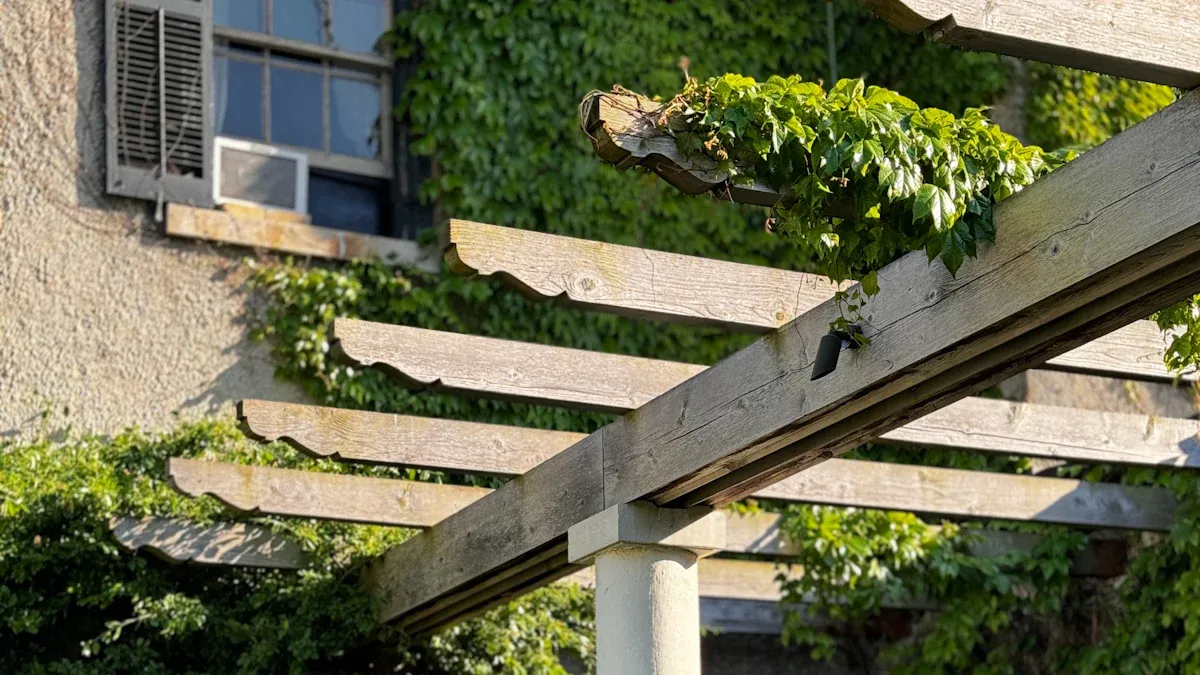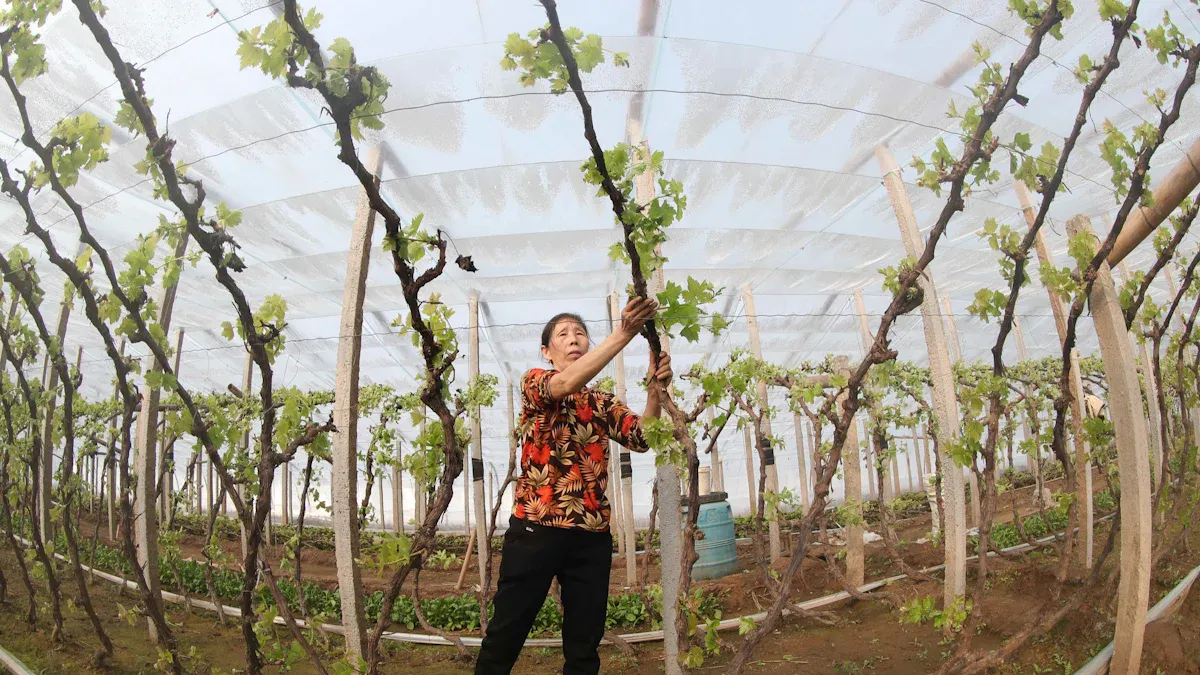Building Long-Lasting Grapevine Trellises for Home Gardens and Vineyards
Ago . 26, 2025 17:16
You want a grapevine trellis construction that lasts many years and supports healthy vine growth. Choosing the best materials and design is crucial for gardens and vineyards. Innovative solutions like Hebeimetals pali per tralicci da vigneto feature powder-coated steel, providing exceptional strength and rust resistance. These vineyard trellis posts withstand wind and rain, ensuring durability. Installation is quick and easy, often requiring no special tools, especially with systems like Easy-Post. Various anchoring options allow you to adapt to your soil type and maintain stability, making the setup process both simple and secure.
Key Takeaways
-
Pick strong materials that do not rust, like galvanized steel posts. This helps your trellis last a long time and need less fixing.
-
Use a good trellis system to hold up grapevines. This helps sunlight and air reach the plants. It lowers disease and makes better fruit. You can also get more grapes.
-
Put posts in the ground with care. Space them about 5 feet apart. Dig holes deep so the trellis stays steady and wires stay tight.
-
Check your trellis often for loose wires or posts that lean. Look for any damage. Fix problems early to keep vines healthy and safe.
-
Cut back your grapevines every year. Tie the canes to the trellis wires. This helps the vines grow well and makes fruit better. It also makes caring for the plants easier.
Vineyard Trellis Post Benefits
Health and Productivity
A good trellis system helps your grapevines grow strong. It gives them support to stand up straight. The vines can get more sunlight and better air flow. This helps the leaves catch more light. The plant makes more energy from this light. Your grapevines can then grow more fruit. The grapes will also be better quality.
Researchers say trellis systems like vertical shoot positioning (VSP) help vines adjust to different weather. In one study, grapevines on a VSP trellis used water better. The air around the plant was also improved. This helps vines do well during dry times. Modern trellising lets you control the canopy. You can manage how much water the plant loses. You can also control how much light the grapes get. These things help you get more grapes. They also make your grapes taste better.
Tip: You do not need a big vineyard to use trellising. Even in a small garden, a trellis helps your grapevines grow better and make more fruit.
Trellis systems also keep your vines safer from disease. For example, the VSP system makes a canopy that dries fast after rain. This makes it harder for fungal diseases like downy mildew to spread. You will see less rot and fewer diseases. This means you can pick more healthy grapes.
Maintenance and Harvest
Trellises make it easier to care for your grapevines. When vines grow on wires or posts, you can prune and spray them easily. You can check for pests without dealing with tangled branches. It is also easier to reach the fruit when you pick grapes. This saves you time and work.
Here is a table that shows how different trellis systems help with care:
|
Trellis System |
Maintenance Advantages |
|---|---|
|
General Trellising |
Holds up vines, gives more sun and air, makes pruning and picking easier |
|
VSP |
Lowers disease risk, helps with machine pruning and picking, helps manage the canopy |
|
High Cordon |
Needs little care, works well with machine picking |
|
T Trellis |
Strong for heavy fruit, easy to prune, keeps fruit safe from soil diseases |
|
Lyre System |
Controls vine growth, gives more air and light, helps fruit ripen well |
Using a trellis also makes it easier to remove leaves or thin grape bunches. This helps grapes ripen at the same time. It keeps the vines healthy too. Trellises help with machine picking in big vineyards. But even in a home garden, picking grapes is much easier. With less disease and easy access, you get a bigger and better harvest every year.
Trellis Types

Horizontal Wire
Horizontal wire trellis systems are common in gardens and vineyards. This type uses metal posts called T posts. Wires stretch between these posts. You install the posts by pounding them into the ground. The wires run straight across the soil. They hold up grapevines as they grow. Horizontal wire systems cost less at first. They need fewer materials. Metal T posts last a long time. They do not rot or break in bad weather. You spend less time fixing them. Metal posts almost never need to be replaced.
Here is a table that shows how horizontal wire trellises and wooden crossbar trellises compare:
|
Aspect |
Horizontal Wire Trellis (T Posts) |
Wooden Crossbar Trellis (T Trellis) |
|---|---|---|
|
Cost |
Lower upfront cost, fewer materials needed |
Higher upfront cost, more hardware required |
|
Installation |
Easier, pound posts into ground |
More labor, dig holes and set posts |
|
Durata |
Metal posts last 18+ years, resist rot |
Wood lasts 4-5 years, prone to rot |
|
Maintenance |
Easy, less frequent replacement |
Ongoing, posts may pull away or rot |
|
Effectiveness |
Good for erect varieties, wires need tensioning |
More room for growth, supports heavy fruit |
|
Suitability |
Best for budget-conscious growers |
Preferred for heavier, trailing varieties |
Tip: Use strong end posts to keep wires tight and steady.
Alternatives
There are other trellis systems you can use for grapevines. Each system works best for certain grape types and places. Some popular choices are High Cordon, Umbrella Kniffen, Geneva Double Curtain, Vertical Shoot Positioning, and Scott Henry. These systems help different grapes grow well. They also work in many climates.
|
Trellis System |
Suitable Grape Types |
Site/Vigor Considerations |
Mechanical Harvesting Suitability |
|---|---|---|---|
|
High Cordon (HC) |
American, French-American hybrids |
Moderate vigor sites |
Good for mechanical harvesting |
|
Umbrella Kniffen |
American, French-American hybrids |
Moderate vigor, simpler terrain |
N/A |
|
Geneva Double Curtain |
American, French-American hybrids |
Vigorous sites, divided canopy system |
Good for mechanical harvesting |
|
Vertical Shoot Positioning (VSP) |
European Vitis vinifera |
Best for vinifera grapes, upward growth |
Good for mechanical harvesting |
|
Scott Henry |
Vigorous cultivars/sites |
Vertically divided canopy, more fruit |
Less suited for mechanical harvesting |
Pick a trellis system that matches your grape type, site strength, and harvest plans.
End Post Assemblies
End post assemblies are important for grapevine trellis building. These posts hold the wires and keep the trellis steady. Strong end posts give you many benefits:
- 👍Better anchoring for wire systems with high tension
- 👍Many years of good service in hard weather
- 👍Quick setup with tractor-mounted drivers
- 👍Holes and hooks for easy wire tightening
- 👍Rolled edges for machine harvester use
- 👍Extra strength and toughness with top wood or steel
- 👎Steel posts have coatings like Corten or galvanized for protection
Note: End post assemblies make your trellis last longer and hold heavy fruit well.
Materiali
Wood
Wooden posts make your trellis look classic. Many people pick wood because it feels natural and costs less at first. Wood helps insects and birds live in your garden. This is good for nature. Wood comes from trees, so it seems better for the earth. But wood needs care every year. You have to check for rot and bugs often. Bugs can hurt wood, so you may need new posts sooner. This means more work and money as time goes on.
Tip: Wood is good for a small garden if you like old-fashioned looks. For big vineyards, wood can be too much work.
Metallo
Metal posts are strong and last a long time. Most metal posts stay good for 20 to 30 years. You can put them in fast, and they do not break in bad weather. Metal posts have rolled edges and notches to help hold vines. Some metal posts can rust, but they still stay strong. New metal posts, like Hebeimetals Vineyard Posts, use galvanized steel and powder coating. These things stop rust and keep posts safe from rain and sun. Powder coating lets you choose colors and adds more safety. Hebeimetals has many shapes and sizes, so you can pick what you need for your trellis.
- Galvanized steel stops rust and damage.
- Powder coating makes posts last longer and gives color choices.
- Fast setup saves you time and work.
- Many shapes fit any garden or vineyard.
Concrete
Concrete posts give your trellis a strong base. People use concrete where wind is strong or soil is heavy. Concrete lasts many years and does not rot or get bugs. But concrete posts are very heavy and hard to move. You need special tools to put them in. Making concrete is harder on the earth than wood or metal.
Filo
Wire links your posts and holds up the vines. You need wire that is strong and does not break or sag. Galvanized wire is best because it does not rust. The wire should stay tight so vines can grow straight and healthy.
|
Materiale |
Durata |
Maintenance Needs |
Environmental Impact |
Cost Over Time |
|---|---|---|---|---|
|
Wood |
Lower |
High |
Supports biodiversity |
Higher (replacement) |
|
Metallo |
High (20-30 yrs) |
Low |
Longer lifespan, less waste |
Lower (long-term) |
|
Concrete |
High |
Low |
Higher production footprint |
Moderate |
|
Filo |
High (galvanized) |
Low |
Minimal |
Low |
Note: Picking materials that last longer, like galvanized steel, helps the earth by making less waste.
Grapevine Trellis Construction Guide

Site Selection
Start your grapevine trellis construction by picking the right spot. Grapevines need full sun for most of the day. Choose a place that gets at least 6-8 hours of sunlight. Good air flow helps keep vines dry and healthy. Avoid low spots where water collects after rain. Well-drained soil works best for grapevines. If you have a slope, plant your trellis along the contour to prevent erosion and help water drain away.
Tip: Face your trellis north to south. This direction gives your vines even sunlight and helps prevent fruit rot.
Tools and Checklist
Gather all your tools before you begin. This makes the job easier and faster. Here is a checklist to help you get ready:
- Tape measure
- Shovel or post hole digger
- Hammer or post driver
- Level
- Wire cutters
- Pliers
- Galvanized wire (10-12 gauge)
- Posts (such as Hebeimetals Vineyard Posts)
- Hose clamps or wire ties
- Stakes for young vines
- Gloves and safety glasses
Note: Using Hebeimetals Vineyard Posts can save you time. These posts are easy to install and come in different sizes for your needs.
Measuring and Marking
Careful measuring and marking help your grapevine trellis construction stay straight and strong. Follow these steps:
-
Use 8-foot tall posts for your trellis.
-
Space each post 5 feet apart. This distance supports each grapevine section.
-
Mark the ground with stakes or spray paint where each post will go.
-
For stability, plan to dig each post hole about 1.5 feet deep.
-
If you want to grow more than one plant, add extra posts. For example, three grapevines need four posts.
Tip: Double-check your measurements before digging. Straight rows look better and make maintenance easier.
Installing Posts
Strong posts are the backbone of your trellis. Here is how you can install them for maximum stability:
-
Drive each post at least one foot deep into the ground. For best results, go 1.5 feet deep.
-
Make sure each post stands straight up and down. Use a level to check.
-
Space posts 5 feet apart, lining them up with your marks.
-
For larger trellises, add extra support posts in the center to prevent sagging.
-
Use textured or fiberglass posts if your soil is loose. These grip the soil better.
-
After setting the posts, attach the trellis frame or wires using hose clamps or wire ties.
Hebeimetals Vineyard Posts make this step easy. Their design allows for quick installation and strong anchoring, even in tough soil.
Adding Wires
Wires support your grapevines as they grow. Setting them up the right way helps your vines stay healthy and productive.
|
Best Practice / Description |
Materials / Notes |
|
|---|---|---|
|
End Posts |
Install 2-3 feet deep. These posts hold the tension from wires and vines. Height depends on how tall you want your canopy. |
Use steel, wood, or concrete. Hebeimetals steel posts offer extra strength and durability. |
|
End Post Brace |
Add a brace wire or anchor to keep end posts from leaning. |
Use metal earth anchors or a tie-back post with wire or cable. |
|
Line Posts |
Place every 21-28 feet to reduce wire sag. These posts support the wires between end posts. |
Use metal or wood. Hebeimetals posts work well for this. |
|
Fruiting Wire |
This wire holds the main vine arms and fruit. It carries most of the weight. |
Use single galvanized wire, 10-12 gauge. Attach through holes or clips on posts. |
|
Training Stakes |
Support young vines until they reach the wires. |
Use bamboo, wood, or metal. |
|
Catch Wires |
Guide shoots upward and keep them tidy. |
Use double wires with tensioners or connectors. |
-
Space horizontal wires about 1.5 feet apart vertically.
-
Set the lowest wire at a comfortable working height, usually mid-chest.
-
Pull wires tight and secure them with washers, ferrules, or stoppers.
-
For best results, run wires north to south for even sun.
Tip: Regularly check wire tension. Tight wires give better support and last longer.
End Post Assembly Steps
End posts keep your trellis stable and wires tight. Follow these steps for a strong end post assembly:
-
Dig the end post holes 2-3 feet deep for extra strength.
-
Place the end posts in the holes and check they are vertical.
-
Backfill the holes with soil or concrete for added stability.
-
Attach a brace wire or anchor from the top of the end post to the ground or a tie-back post.
-
Secure the brace wire tightly to prevent the end post from leaning.
-
Connect the main trellis wires to the end posts using strong clamps or hardware.
Hebeimetals offers end posts designed for easy wire attachment and strong anchoring. Their posts resist bending and hold up under heavy fruit loads.
Mistakes to Avoid
Avoiding common mistakes will help your grapevine trellis construction last for many years. Here are some pitfalls and how to prevent them:
-
Do not space posts too far apart. Posts spaced more than 5 feet apart can cause wires to sag.
-
Always dig post holes to the same depth. Uneven holes make the trellis unstable.
-
Set posts straight and tamp the soil firmly around them. Leaning posts can fall over.
-
Pull wires tight and secure them well. Loose wires will not support your vines.
-
Do not skip seasonal maintenance. Check wires and posts every year, especially before pruning.
-
Use a proven trellis design. Letting vines sprawl without support can hurt fruit quality.
Note: If you run into problems during installation, check that all posts are vertical and wires are tight. If a post feels loose, add more soil or use concrete for extra support.
Vineyard Post Maintenance
Seasonal Checks
You should inspect your trellis system at the start of each season. Look for loose wires, leaning posts, or signs of rust and rot. Walk along the trellis and gently shake the posts. If any post feels wobbly, add soil or tamp it down. Check the wires for tension. Tighten them if they sag. Examine the base of each post for moisture or insect damage. Early detection helps you avoid bigger problems later.
Tip: Mark your calendar for a spring and fall inspection. Regular checks keep your trellis strong and your vines healthy.
Repairs
When you find damage, act quickly to fix it. Here are the most effective repair techniques:
-
Apply a wood stabilizer to harden soft or rotting wood and stop further decay.
-
Use epoxy putty to fill gaps or missing wood after stabilizing.
-
Remember, Flex Seal can create a temporary waterproof barrier but does not stop rot.
-
Replace any trellis part that is too rotten or broken for long-term strength.
-
Inspect your trellis often and reapply protective coatings as needed.
Metal posts like Hebeimetals Vineyard Posts usually need less repair, but you should still check for scratches or chipped coatings.
Pruning
Pruning is one of the most important jobs for grapevine health. When you prune, you help your vines grow the right way. Pruning controls the size and shape of the plant. It also balances leaf growth and fruit production. You should prune before new growth starts in spring. This helps you manage how many buds and grape clusters each vine will have. Good pruning leads to better fruit quality and keeps your vines strong year after year. Trellises make pruning easier because you can see and reach every part of the vine.
Troubleshooting
Sometimes, problems happen even with good care. Use this table to spot common issues and find solutions:
|
Problem Category |
Specific Issues |
Solutions / Recommendations |
|---|---|---|
|
Structural Integrity |
Trellis not strong enough for mature vines; risk of collapse |
Build a sturdy trellis before planting; make sure it can hold heavy vines and resist wind |
|
Spacing & Growth |
Vines spreading beyond 5-foot span, poor vine management |
Prune every year to keep vines within a 5-foot span; choose strong leaders to guide growth |
|
Airflow & Disease |
Poor airflow causing fungal diseases like powdery mildew, rust, blight |
Design your trellis for good airflow; prune to open the canopy; use baking soda sprays or copper fungicides |
|
Pest Infestation |
Pests such as Japanese beetles, ants, aphids damaging vines |
Use organic pest control: plant herbs like basil or marigolds nearby, try neem oil or insecticidal soaps |
Note: Quick action keeps small problems from turning into big ones. Regular care helps your trellis and vines last for many years.
Building a long-lasting grapevine trellis starts with careful planning and smart choices. You should follow these best practices:
-
Prune young vines each year to shape growth and strengthen roots.
-
Tie canes to trellis wires to guide the vine and support fruit.
-
Check soil health and control weeds to keep vines strong.
-
Protect vines from disease by pruning during dormancy and removing old canes.
-
Choose a trellis system that fits your climate and grape variety.
Using high-quality materials like Hebeimetals Vineyard Posts gives your vines strong support and helps them stay healthy for many seasons. With these steps, you can enjoy better harvests in both home gardens and vineyards.
Vineyard Trellis Post FAQ
How often should you check your grapevine trellis for problems?
You should check your trellis at least twice a year. Look for loose wires, leaning posts, or signs of rust. Early checks help you fix small issues before they become big problems.
What is the best material for a long-lasting grapevine trellis?
Galvanized steel posts, like Hebeimetals Vineyard Posts, last the longest. They resist rust and damage from weather. You spend less time on repairs and replacements.
Can you use the same trellis for other climbing plants?
Yes! You can use your grapevine trellis for plants like tomatoes, hops, or beans. The strong posts and wires support many types of climbing crops.
How do you keep wires tight on your trellis?
Tip: Use wire tensioners or turnbuckles. Tighten the wires each spring. This keeps your vines supported and your trellis strong all season.


















